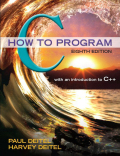
EBK C HOW TO PROGRAM
8th Edition
ISBN: 9780133964639
Author: Deitel
Publisher: PEARSON CUSTOM PUB.(CONSIGNMENT)
expand_more
expand_more
format_list_bulleted
Question
Chapter 20, Problem 20.14E
Program Plan Intro
Program Plan:
- Use the class hierarchy created in Exercise 19.10.
- Add user interaction part by allowing users to input the amount being credited or debited.
- Modify the information provisioning functionality by informing about the account balance after each interaction based on the account type.
Program Description:
We will have three classes Account, SavingsAccount and CheckingAccount with desired attributes and operations. We will re-use the class hierarchy created in Exercise 19.10 and make use of virtual functions for implementing credit and debit operations. Usage of virtual functions and overridden methods in the hierarchy will demonstrate dynamic polymorphism and reduce the code overhead significantly.
Expert Solution & Answer
Want to see the full answer?
Check out a sample textbook solution
Students have asked these similar questions
Dijkstra's Algorithm (part 1). Consider the network shown below, and Dijkstra’s link-state algorithm. Here, we are interested in computing the least cost path from node E (note: the start node here is E) to all other nodes using Dijkstra's algorithm. Using the algorithm statement used in the textbook and its visual representation, complete the "Step 0" row in the table below showing the link state algorithm’s execution by matching the table entries (i), (ii), (iii), and (iv) with their values. Write down your final [correct] answer, as you‘ll need it for the next question.
4. |z + 5 - 5i| = 7
14.
dz,
C: |z❘
C: |z❘ = 0.6
ze² - 2iz
H
Chapter 20 Solutions
EBK C HOW TO PROGRAM
Ch. 20 - Prob. 20.3ECh. 20 - (Polymorphism vs. switch logic) Discuss the...Ch. 20 - (Inheriting Interface vs. Implementation)...Ch. 20 - Prob. 20.6ECh. 20 - (Dynamic Binding vs. Static Binding) Distinguish...Ch. 20 - Prob. 20.8ECh. 20 - (Abstract Base Classes) Suggest one or more levels...Ch. 20 - Prob. 20.10ECh. 20 - (Polymorphic Application) Youve been asked to...Ch. 20 - (Payroll System Modification) Modify the payroll...
Knowledge Booster
Similar questions
arrow_back_ios
SEE MORE QUESTIONS
arrow_forward_ios
Recommended textbooks for you
 C++ for Engineers and ScientistsComputer ScienceISBN:9781133187844Author:Bronson, Gary J.Publisher:Course Technology Ptr
C++ for Engineers and ScientistsComputer ScienceISBN:9781133187844Author:Bronson, Gary J.Publisher:Course Technology Ptr C++ Programming: From Problem Analysis to Program...Computer ScienceISBN:9781337102087Author:D. S. MalikPublisher:Cengage Learning
C++ Programming: From Problem Analysis to Program...Computer ScienceISBN:9781337102087Author:D. S. MalikPublisher:Cengage Learning

C++ for Engineers and Scientists
Computer Science
ISBN:9781133187844
Author:Bronson, Gary J.
Publisher:Course Technology Ptr

C++ Programming: From Problem Analysis to Program...
Computer Science
ISBN:9781337102087
Author:D. S. Malik
Publisher:Cengage Learning